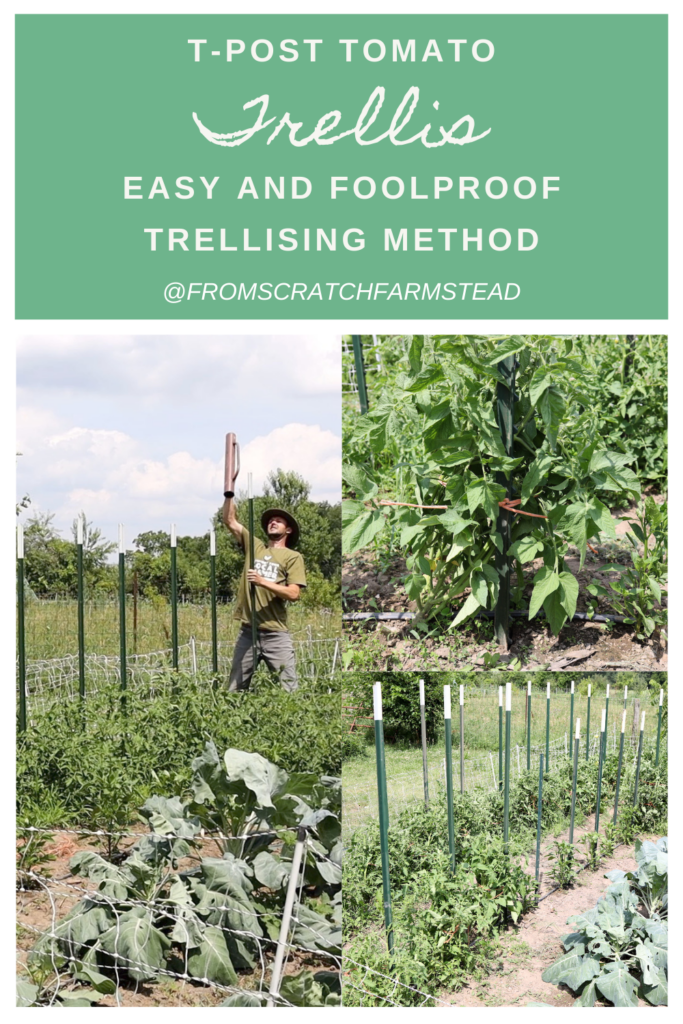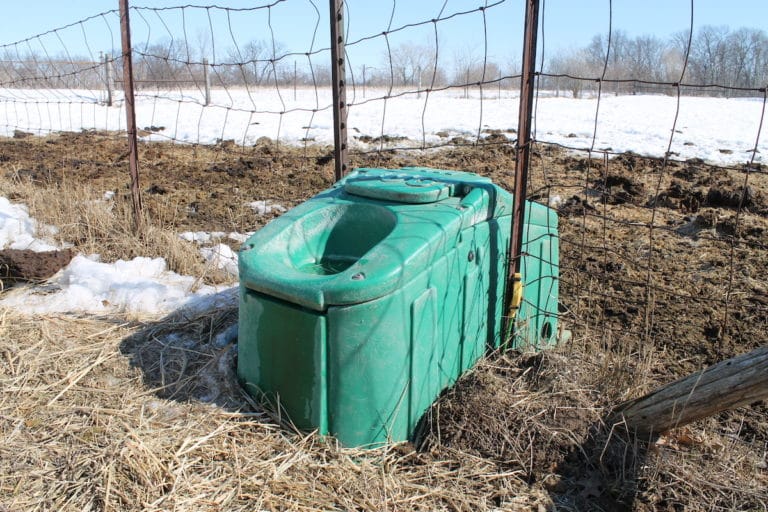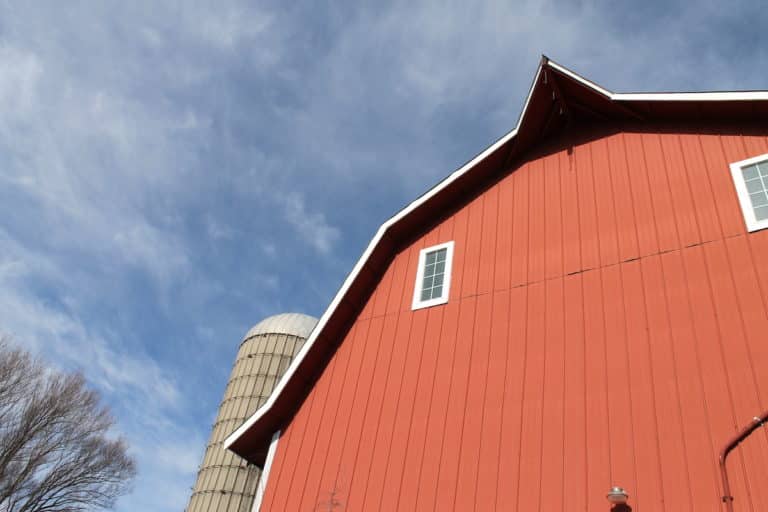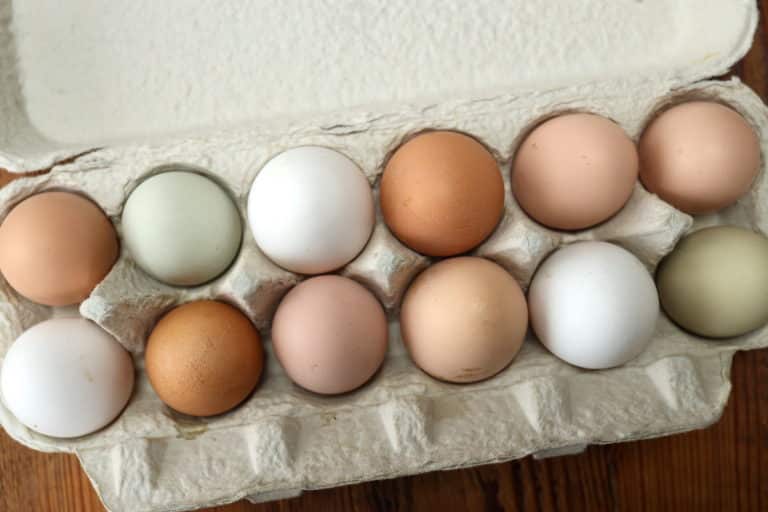T-Post Tomato Trellis – Easy and Foolproof Trellising Method
Whether your tomato plants were just transplanted or they’re a few feet long and flopping over, you need a sturdy, low-cost, and long-term trellis solution. We’ve got you covered with this T-Post Tomato Trellis tutorial.
Common Tomato Trellis Options
Many methods exist to trellis tomatoes. We’ve tried most of them and ultimately landed on t-posts being our preferred choice.
But before we get into the t-post method, what are the other common methods of trellising tomatoes and what are their downsides?
Tomato Cages
Many home gardeners start with tomato cages. We certainly did! Whether square or round, tomato cages are a simple way to get going. However, they can have a few drawbacks. First, you need to install them early! Don’t try and install them once the plant is mature—believe me, I’ve tried! Second, unless you get heavy gauge tomato cages, they may not be substantial enough to support a large tomato plant full of fruit. And finally, They can be a pain to store in the off season and can easily get bent out of shape.
Stakes
Single wood or bamboo stakes are also commonly used to trellis tomatoes. These can work great as long as you get a length big enough to support you plant. Plus you need to drive it into the ground far enough. We’ve had better results using wood stakes for smaller plants like peppers. They’re not always substantial enough to support the weight of full grown tomato plant. Plus, being wood, they don’t last forever.
Florida Weave
Imagine two solid posts placed several feet apart with rope or twine strung horizontally every 6-12” between them. That’s the Florida Weave. As the plant grows, you weave the stems in and out of the rungs for support. We did a version of this our first year on our homestead. Our system probably could have been better executed, but some of the twin we used for horizontal rungs broke from constant sun exposure and the posts at each end started to bend inward from too much weight.
Wood Trellis
Back in our suburban gardening days, I built a ladder style trellis out of scrap wood. It looked cool and I was able to successfully trellis our tomatoes up the ladder rungs. When the whole trellis began to lean to one side about mid-season, I realized my error of not staking it into the ground deep enough. If you have scrap wood to use, this can be a fine trellising option—just make sure it’s plenty supportive for those plants.
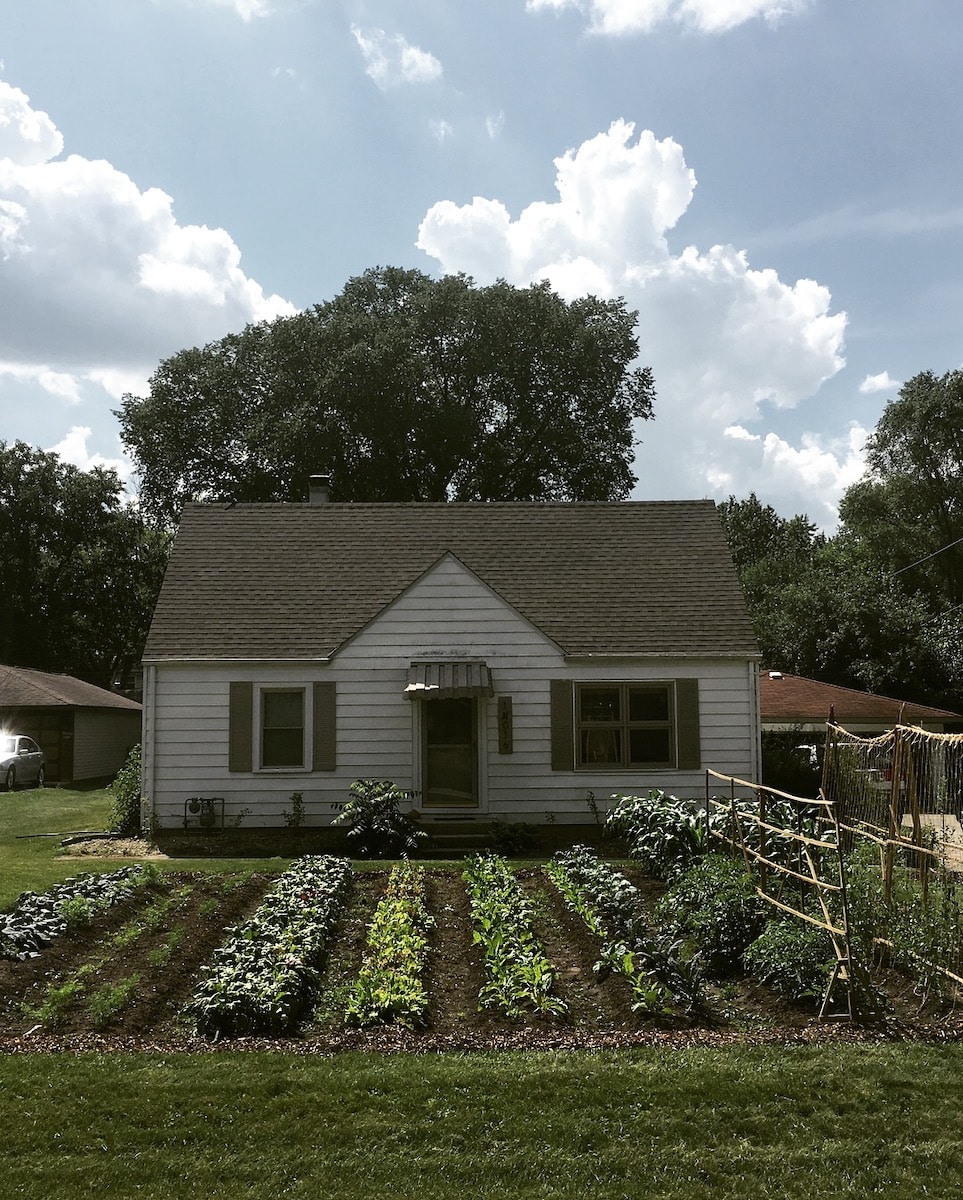
Cattle Panel or Mesh
Cattle panel is a solid metal mesh fence panel that stands 48” tall. It can be tied up vertically to posts and used to trellis tomatoes. Other mesh materials can be used too in a similar fashion. Many gardeners utilize cattle or hog panel in their gardens for trellising with great results. But you still need to use t-posts or some other post to secure the panels to.
T-Posts
My favorite method for trellising tomatoes is using t-posts. One single t-post pounded in to support one single plant. You don’t need to build anything. They’re affordable and easy to come by. They can be installed at any time in the tomato plants life. And one t-post can support even the most abundant of tomato plants and won’t budge.
What is a T-post?
If you didn’t grow up in a rural area, you may be wondering what in the world a t-post even is! No worries, as a former suburbanite I’m right there with you!
T-posts are solid steel posts that are in the shape of a T. Hence, t-post! The flat topside of the T is studded with knobs. There is also a moveable anchor plate near the bottom of the post that helps hold the post in place.
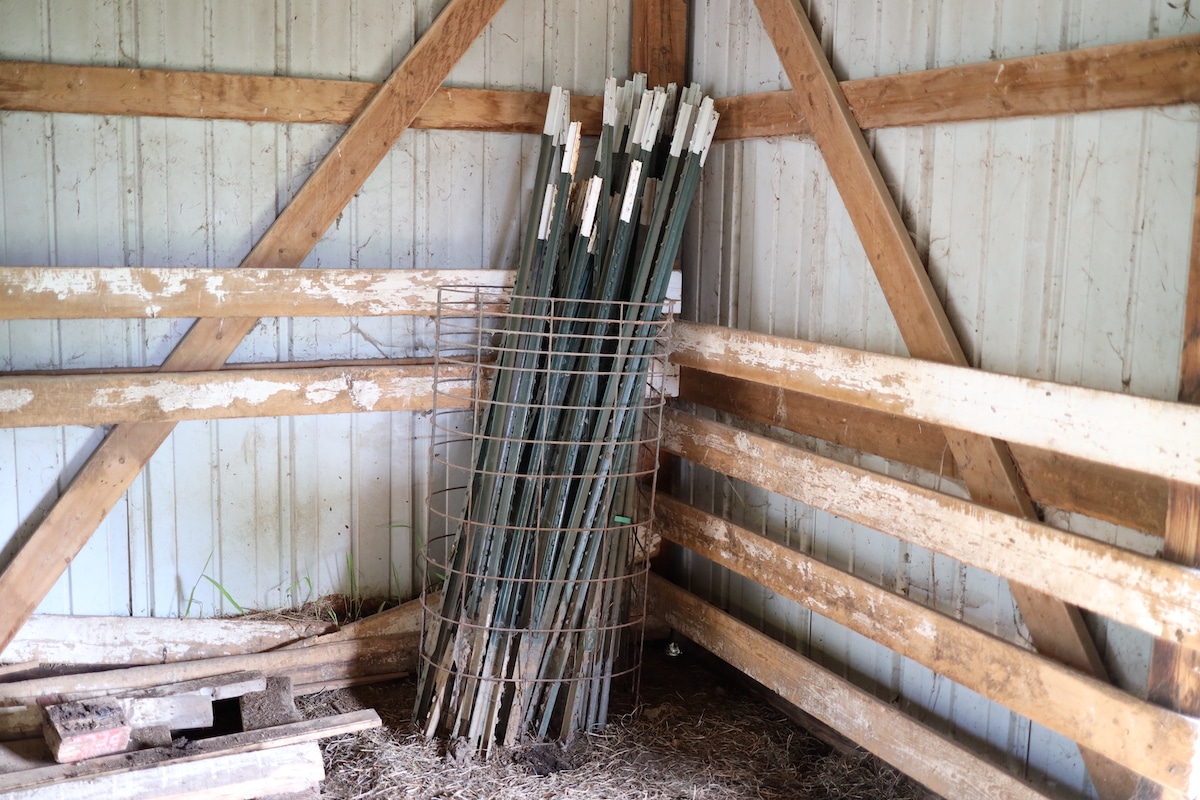
Farmers have been using t-posts for decades. Their most common use is fencing where woven wire or panel fencing can be easily fastened to the t-posts with wire clips.
These sturdy posts have found many other creative and practical uses around the farm or home over the years. Especially in the garden!
Why Use T-Posts to Trellis Tomatoes?
As we’ve seen, there are many ways to trellis tomatoes. So why use t-posts? Let’s dig in!
1. Easy Install
With the help of a t-post driver, pounding in a t-post is a breeze! Am I a bit winded after pounding in around 24 or so of them in our garden? Yes! But the process moves quickly and they’re as stable as can be once installed.
2. Cost Effective
Our 7’ t-posts cost about $7 each from Tractor Supply. That’s not that much when you consider they’ll last a lifetime. The Facebook Marketplace and Craigslist market is also flooded with used t-posts that typically only cost a couple dollars per post.
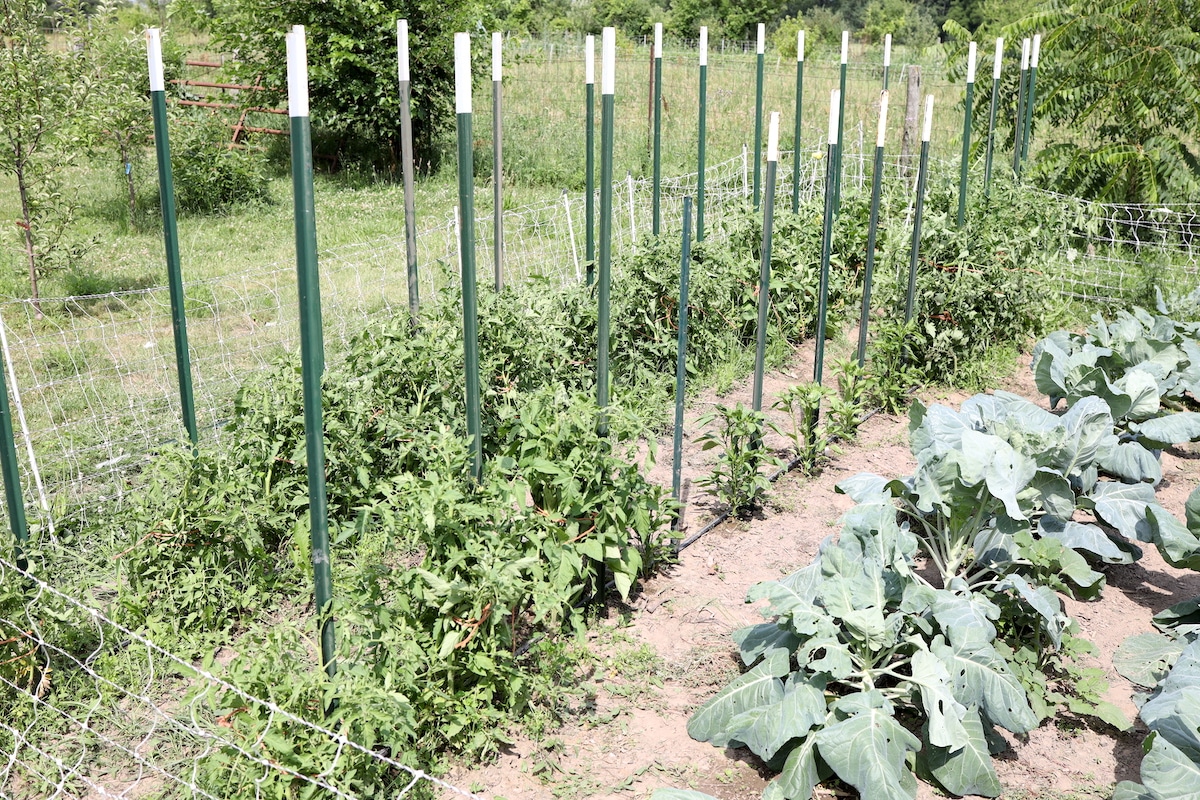
3. They Will Last
T-posts are solid steel. They might rust over time. But they’ll likely outlive you. There’s no welds that can break like on tomato cages and it would take a significant mishap to bend or damage one.
4. Scale To Any Size
This method can be practical whether you have 2, 20, or 200 tomato plants. Simply scale accordingly and add or subtract t-posts as needed.
5. Easy To Disinfect
We personally don’t disinfect our tomato gear to prevent the spread of disease. But for those who do, it doesn’t get any easier than disinfecting one solid steel post before each season.
6. Small Footprint
T-posts add no extra bulk to your garden rows. In fact, the single post helps slim things up. As long as we keep on top of trellising our tomatoes up the t-post, we find the plants stay neat, tidy, and easy to maneuver between.
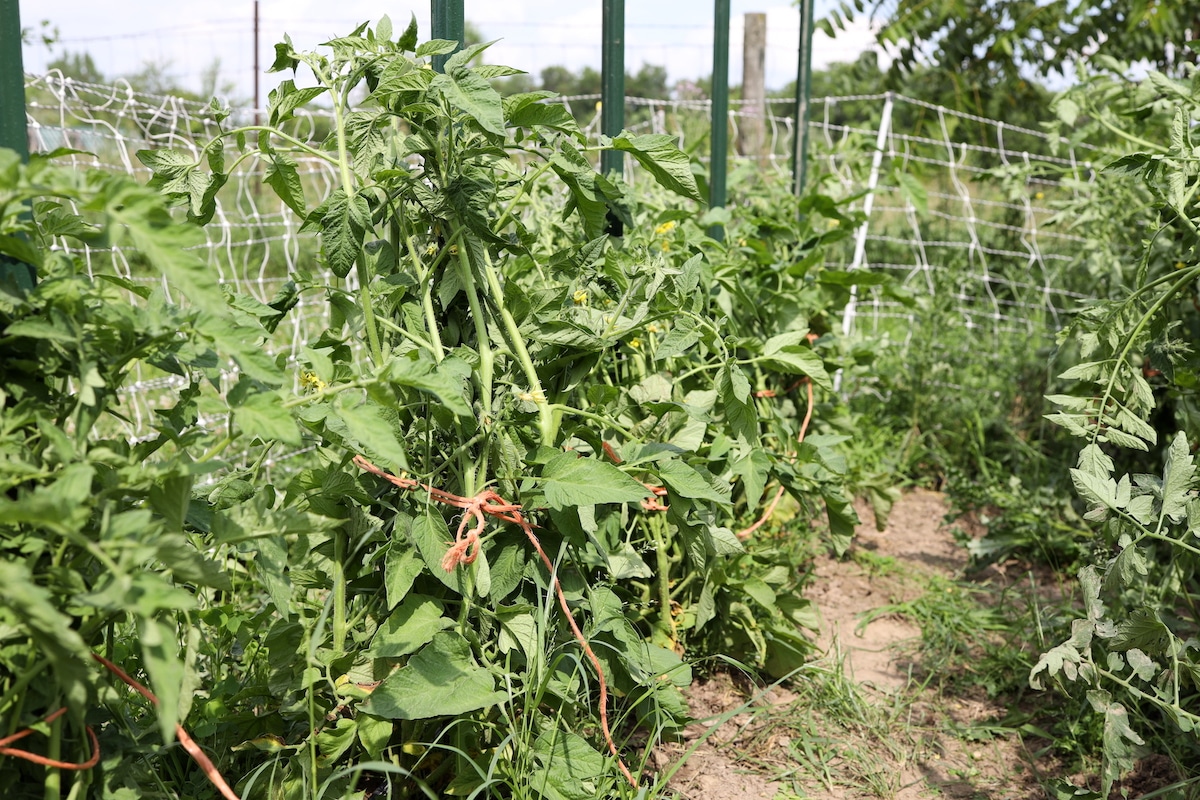
7. Simple Storage
Storing your posts when not in use is easy. We just lean ours up in the corner of our barn. They take up little space and are all set for whenever you need them next.
8. Multi-Use
Sure your t-posts will be employed in your garden during the growing season, but you can likely find other uses for them when they’re available. We use our t-posts for a temporary fencing solution for our cows each winter.
9. Ready To Go
Buy them. Bring them home. Pound them in. And just like that you’re trellising your tomatoes. No need to build anything. T-posts are as quick and simple as it gets.
How To Create a T-Post Tomato Trellis
There’s no need to overcomplicate this process. It really is as simple as pounding in a t-post near the base of your plant and tying up the plant to your t-post.
However, there are some helpful tips I’ve learned over the years that I’ll share with you below.
Step 1 – Gather Supplies
To start, gather up all your supplies and locate them near your garden. Here’s a list:
- T-posts (one per plant)
- T-post Driver
- Twine or Rope
- Scissors or knife
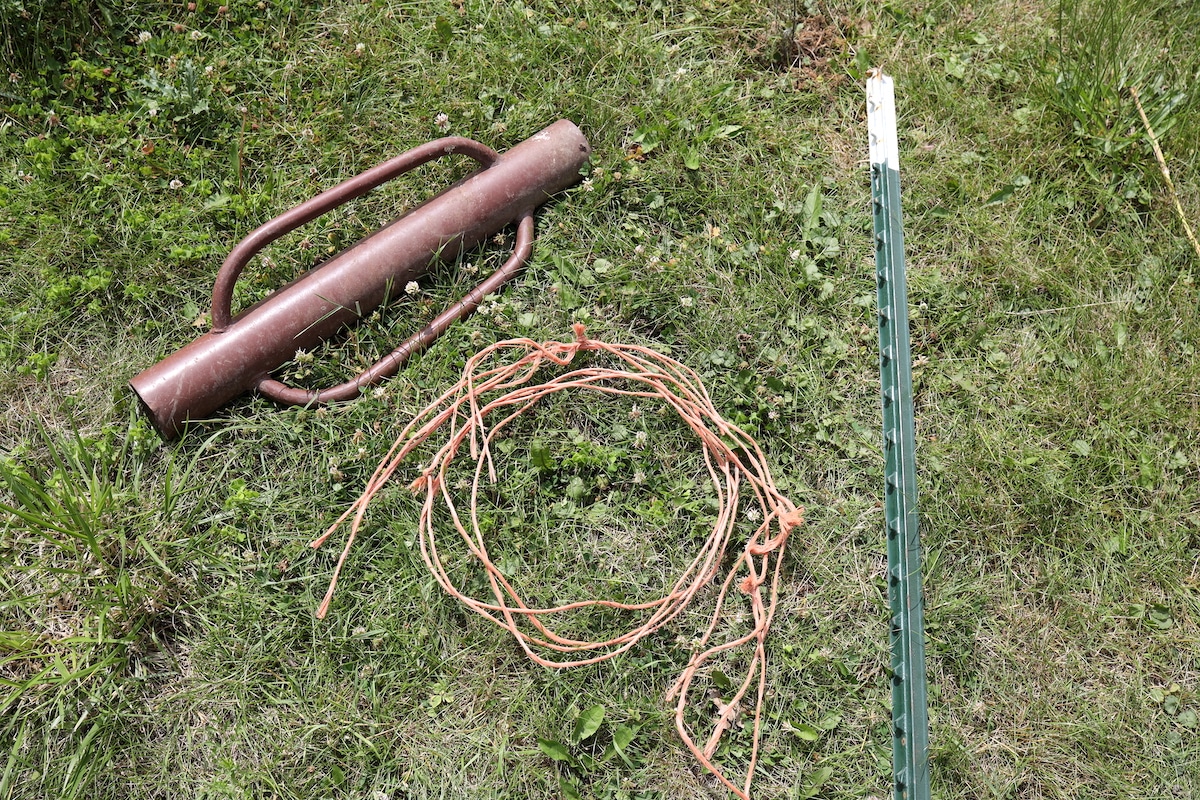
If you are having difficulty reaching to the top of the t-post with the t-post driver then you may also need a small ladder or step stool when pounding them in.
Step 2 – Pound In T-Posts
You will be installing one t-post per plant. Here are some things to note:
- Pound each t-post into the ground about 1 ft. Deep or until the anchor plate is just below the surface.
- Place so the studded side of the t-post is facing away from the plant.
- For more mature plants, locate your t-post 6-8” away from the base of the plant to not disrupt or damage the root structure. Younger plants or new transplants allow for a closer t-post install.
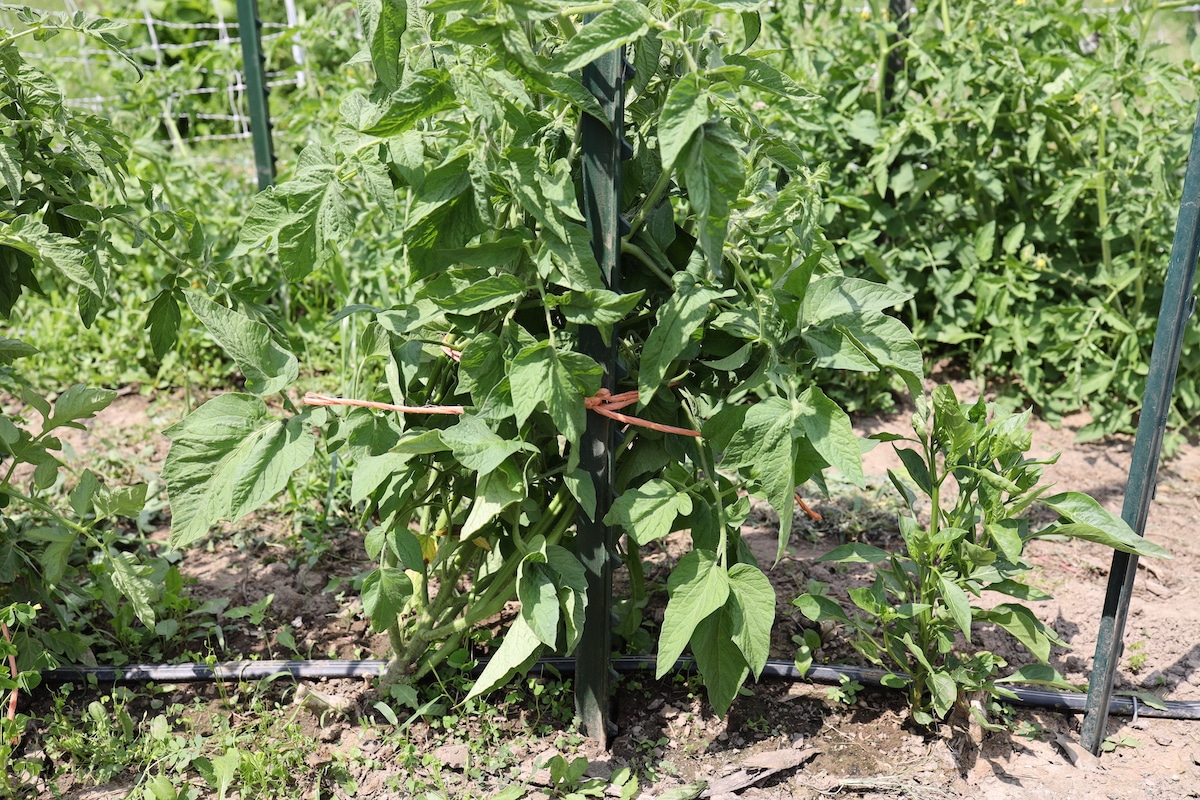
If you are new to using a t-post driver, simply slide the open end of the tube over the top of the t-post. Align the bottom of the post where you want it driven in. Grasp the handles of the driver firmly with two hand, lift about 1 ft. and pound the post in vertically.
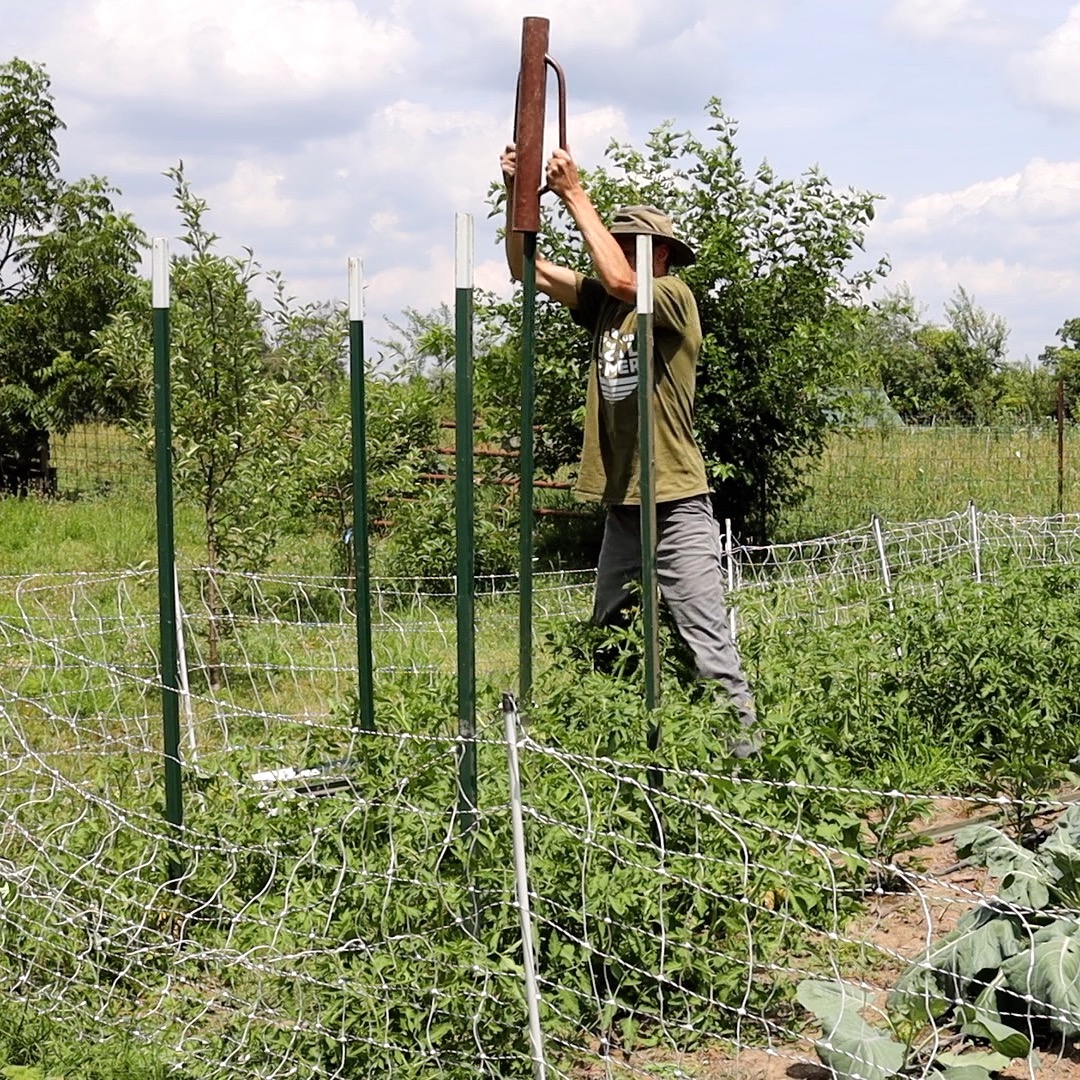
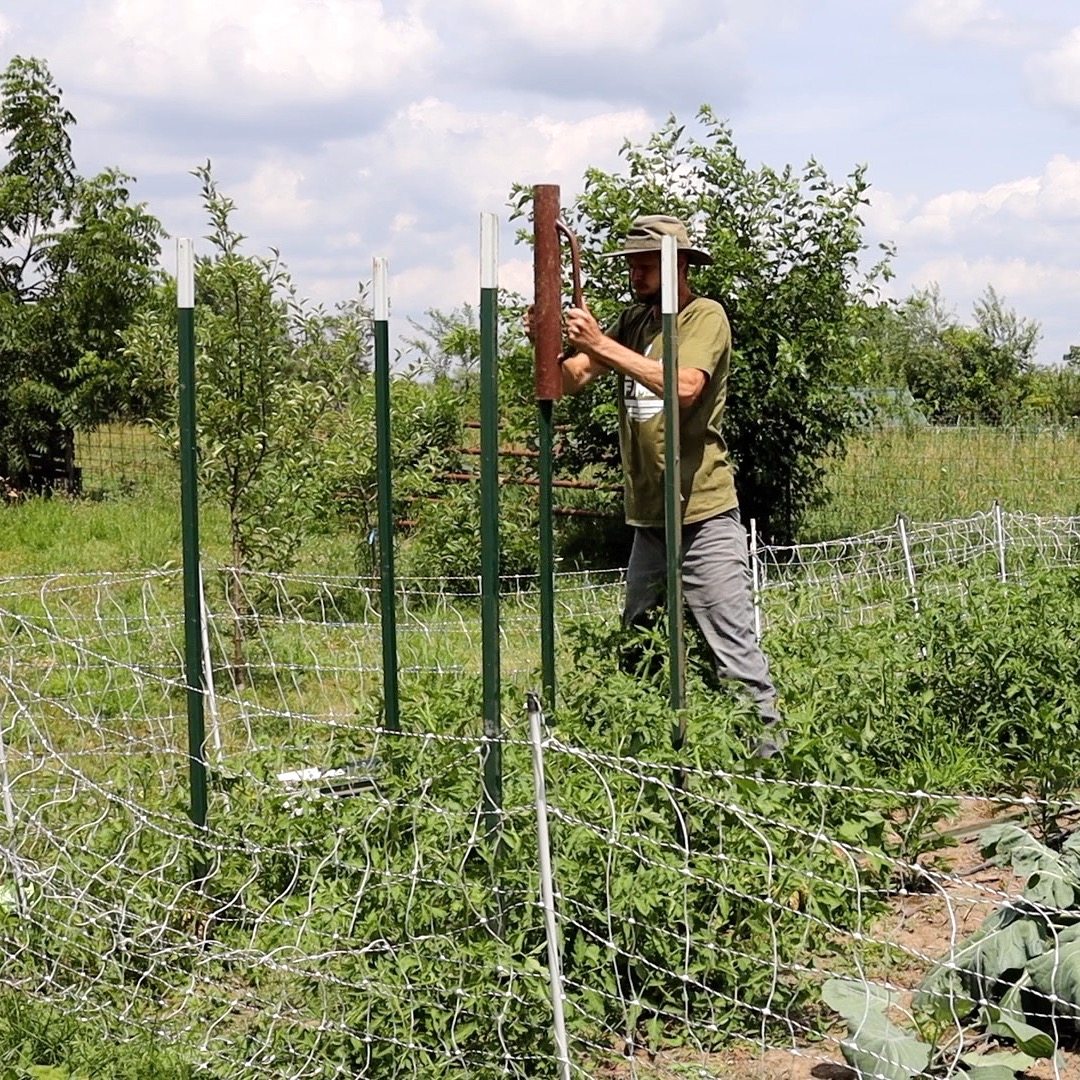
If the post is not going in vertical, pause from pounding and use the driver to pull the t-post in the direction needed to level it out. Then continue pounding. They don’t need to be perfect!
Once you have a post pounded in for each plant that you are trellising, you can move on.
Step 3 – Cut Your Twine or Rope
You’ll need at least one length of twine or rope to tie up each plant. But I like to have extra.
Since tomato plants can be delicate, use something wide enough that it will not cut into the plant. I use baling twine since I always have plenty leftover from small square hay bales. You can also use rope that is on the thicker side. Avoid using wire or something like fishing line.
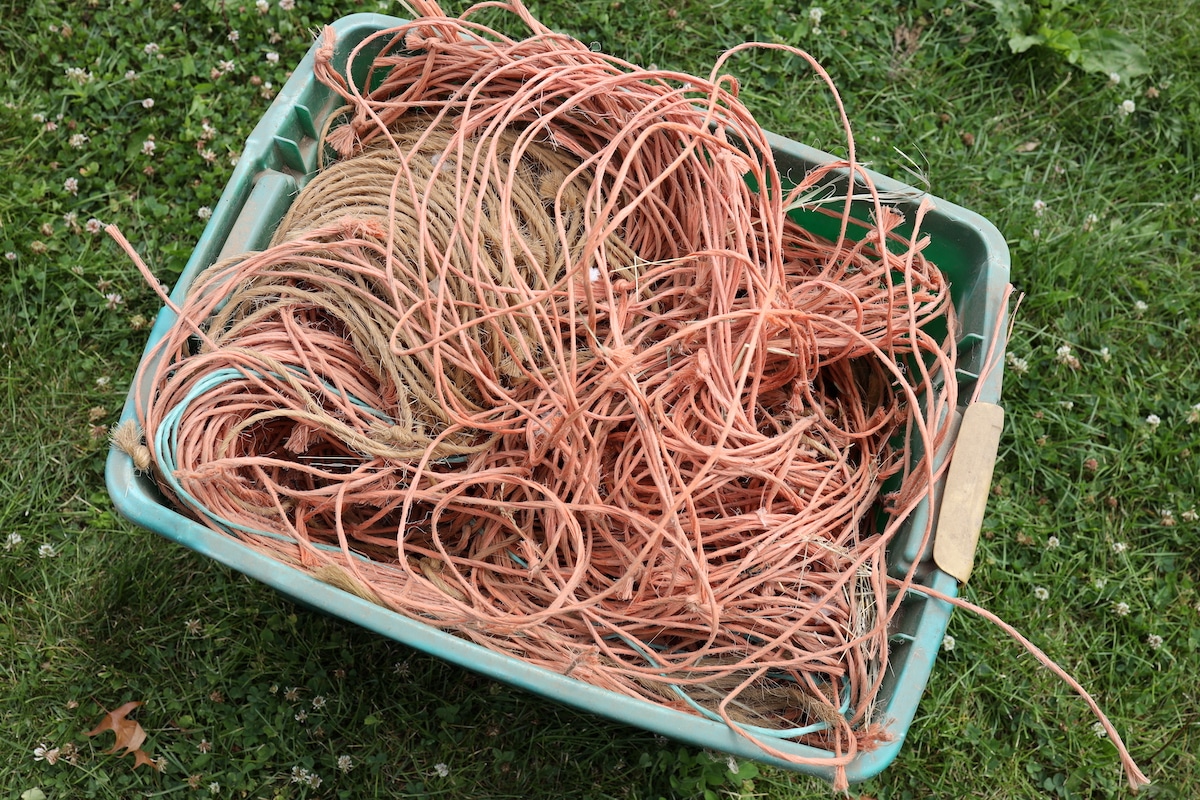
You should trial a length before cutting all your sections for tying up your plants. I use about a 4-5’ length, mostly because that’s the size that comes off the hay bales. You may prefer longer or shorter depending on your plants, layout, and how you tie them.
Regardless, I’ve found it most helpful to take the time to precut however many sections of twine or rope that you will need before you start the next step.
Step 4 – Trellis Your Tomatoes
The key with this step is to take it slow and be gentle! The stems of tomato plants can be fragile and snap easily. Take your time and try to keep everything intact.
Gather up all the stems of your tomato plant bringing them upward and toward the t-post.
Have a tie ready and wrap it around the section of plant where you feel your gathered stems will be most supported. I like to wrap around the plant twice when I’m able.

You want the twine or rope to tight enough to fully support the plant, but loose enough to not choke anything off or bite in too tightly to stems. When in doubt, leave it a bit on the loose side to allow for future growth.
Then tie a knot. It doesn’t have to be anything fancy. Just a knot that will hold all growing season and won’t slip.
If the plants are longer, or you missed a stem, you may need to tie up another section of the plant a little higher up on the t-post.
Step 5 – Continue Trellising!
At this point your tomatoes are trellised! But trellising is an ongoing process all growing season long.
Check in with your plants weekly to observe how much they’ve grown. Keep sections of twine or rope on hand and, as needed, tie up more of your plant to keep them supported and growing upward.
I typically like to make sure there is a tie added about every foot going up the t-post. Keep on top of your continued trellising to avoid plants flopping over or snapping stems.
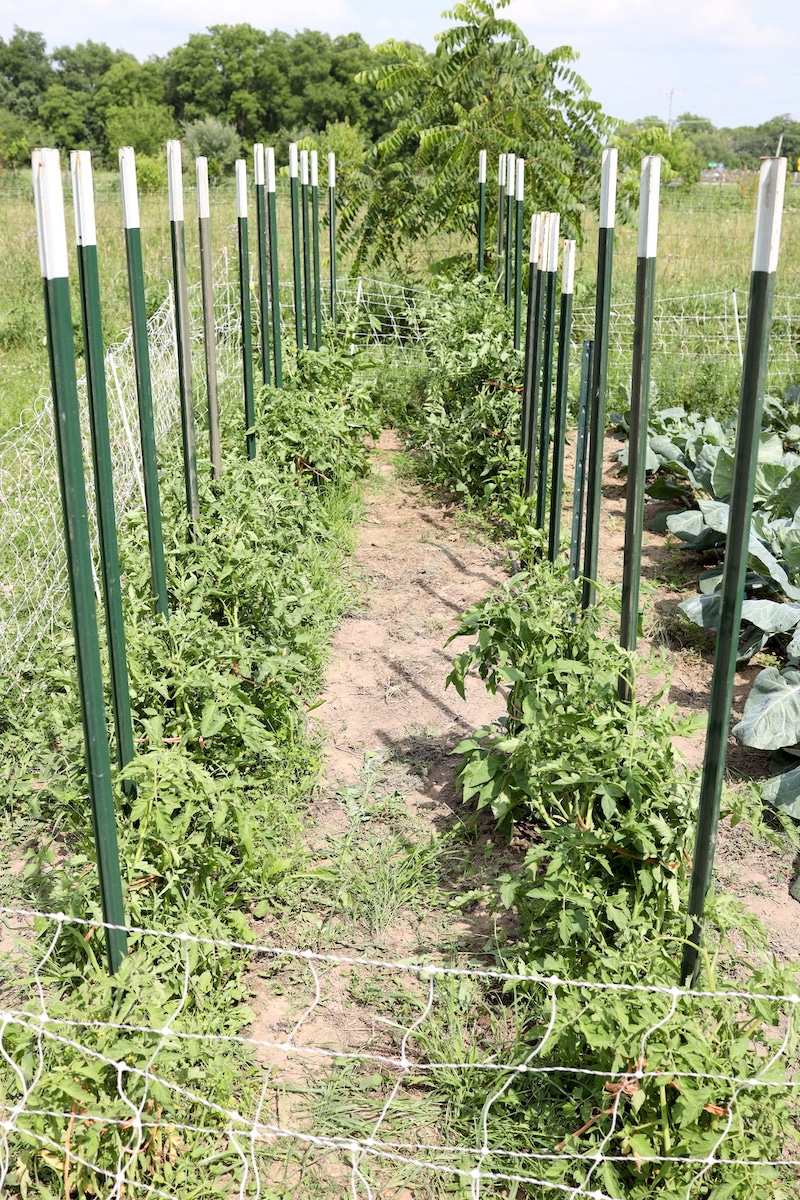
T-Post Tomato Trellis FAQ’s
What is the best size t-post to trellis tomatoes with?
I recommend 7’ t-posts when trellising tomatoes. With a total length of 7’, one foot is below ground leaving 6’ for your tomato trellising. A 6’ t-post gives you 5’ of trellising. While 6’ is usually enough, some tomato plants, like cherry tomatoes or indeterminate varieties, can grow quite tall and need the support of a 7’ post.
Where can I get t-posts?
Most farm stores or larger hardware stores carry t-posts. We got ours from Tractor Supply. T-posts can also commonly be found used. Check Facebook Marketplace or Craigslist in your area to see if there’s a good used option that can save you some money.

How long does it take to trellis tomatoes with T-posts?
Our 24 tomato and pepper plants took me roughly 1 hour to trellis with t-posts. So, based on the number of plants you need to trellis, use that as a baseline for estimating time.
Can T-Posts be used to trellis other plants in the garden?
Yes! We use t-posts for just about anything that needs trellising! Peppers, eggplants, beans, peas, etc. We’ve even had corn from our three sisters garden blow over in strong winds and were set multiple corn and bean plants back to vertical again with a single t-post.
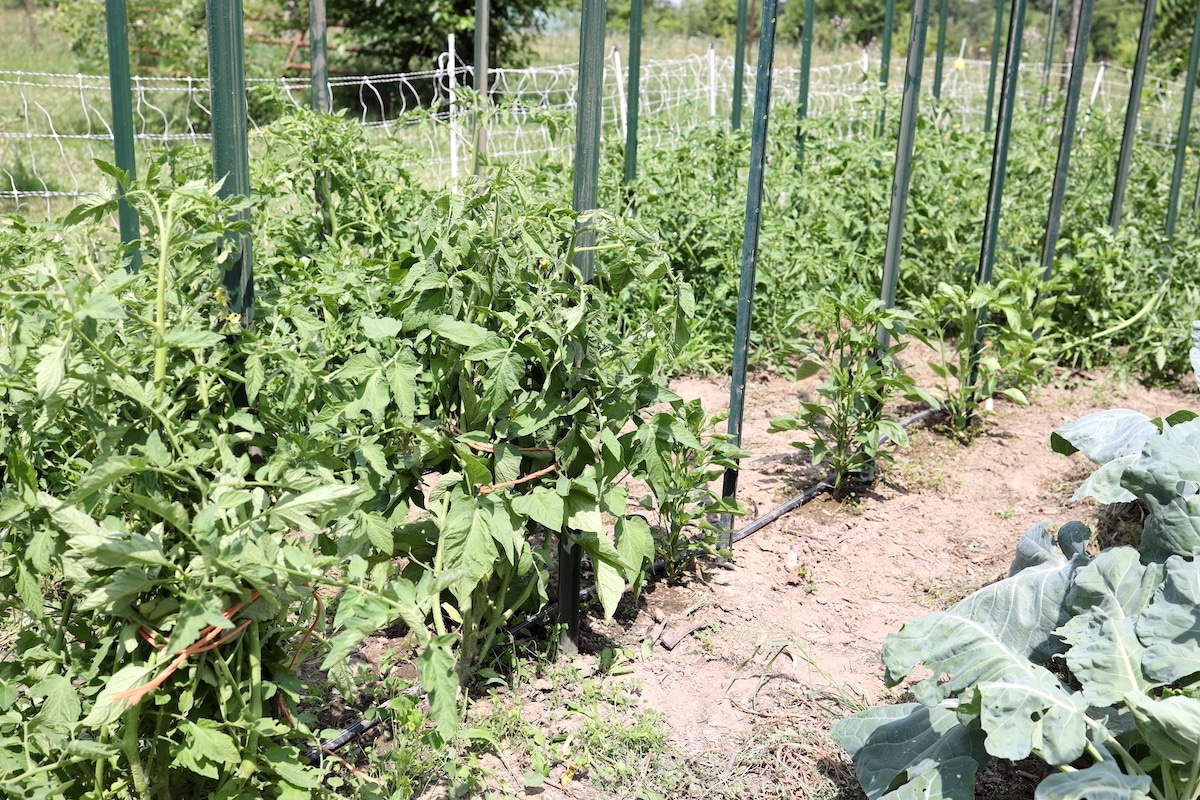
Are there ways to use fewer T-posts?
There are. However, we like the simplicity and security of one post per plant. When you search for trellising with t-posts you’ll come across plenty of other tutorials that span their t-posts out several feet, run a solid bar or pipe horizontally between them on top, and then hang string down for trellising plants. This works. Again, I just prefer to get some extra t-posts, not need to build anything, and do one t-post per plant.
What do you do with T-posts when the garden season is over?
To remove t-posts, just rock them back and forth a few times until they are loose enough to pull out of the ground. We just gather them up and lean them in corner of our barn for storage. Any shed, barn, garage, or basement is great option for stowing away t-posts when not in use.
Some of the above links are affiliate links. This means we earn a small commission on qualifying purchases at no cost to you. We are so appreciative of your support!
Related Posts:
10 Essential Storage Crops You Need To Grow
DIY Seed Starting Mix with Compost
Starting Seeds Indoors Without Grow Lights
How To Build A Drip Irrigation System for your Garden
How To Create A Quarter Acre Self Sufficient Homestead Garden
Pin it for later!
